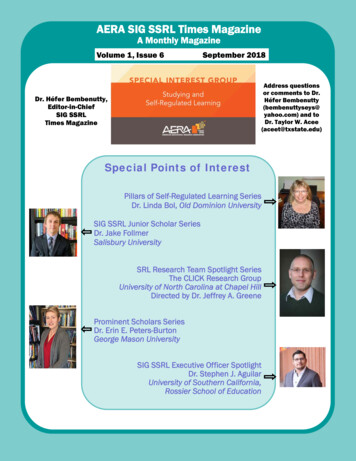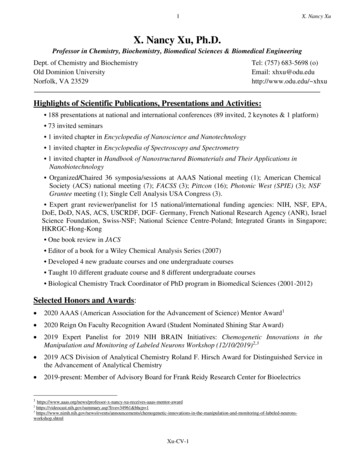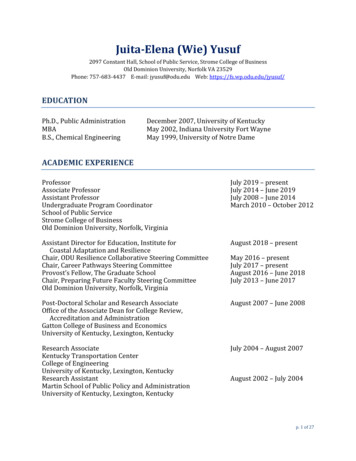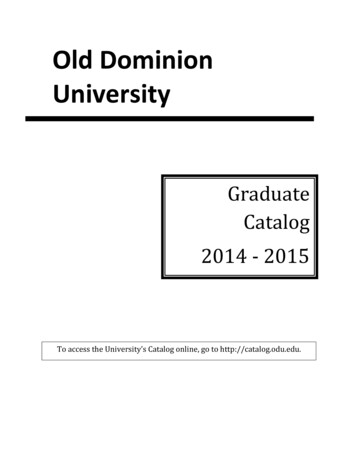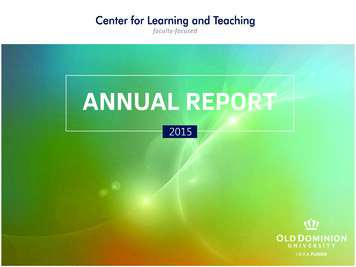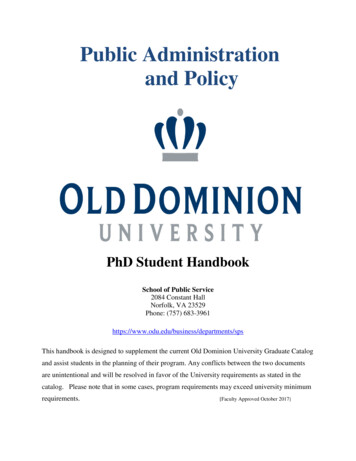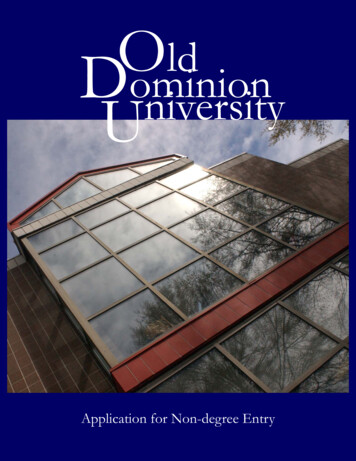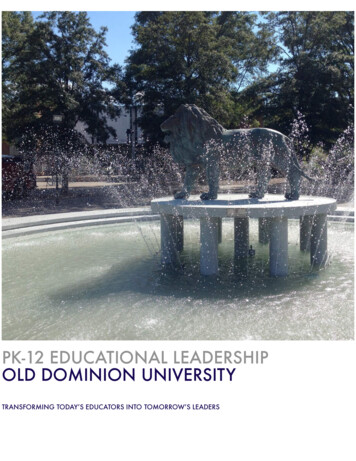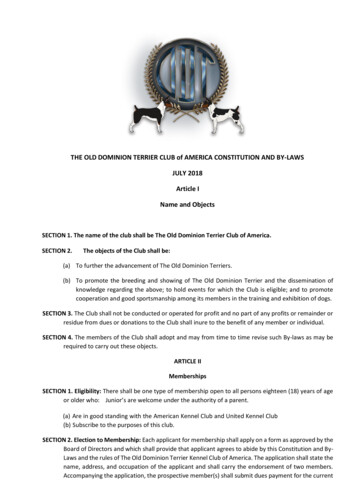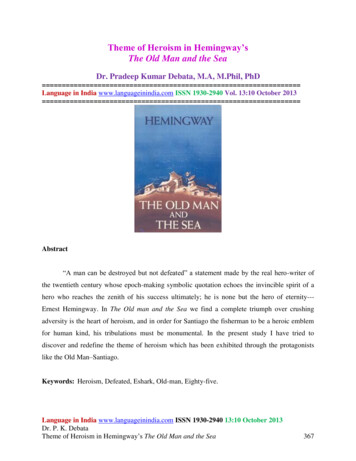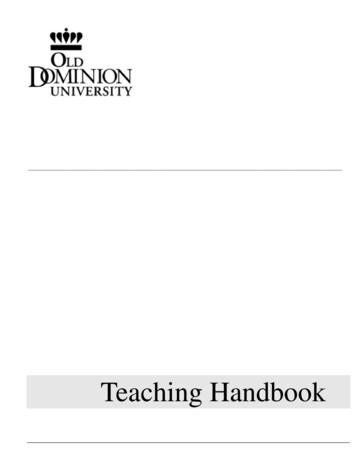
Transcription
Teaching Handbook
OLD DOMINION UNIVERSITYTeaching HandbookForward & AcknowledgementsThis Handbook grew out of our desire to give current and future ODU teaching assistants and instructorsthe knowledge and tools to successfully meet the challenges of preparing our students to be productive andstskilled members of our global 21 Century society. We have drawn from both theoretical and appliedresearch studies and from the best practices used at other major universities. With permission of Dr. KarenthKlomparens, we have incorporated with minor modifications entire sections of the 5 Edition of MichiganState University’s Teaching Assistant manual. We have also drawn upon and incorporated materialsdeveloped by the ODU Center for Learning Technologies. As much as possible, we have providedpractical examples and scenarios to help in the understanding and application of the theoretical principlesand practical recommendations for creating effective active learning and effective teaching strategies. ThisHandbook will require constant revisions to ensure that the pedagogical skills and effectiveness of ODUteaching assistants and instructors are at the highest level possible.Philip J. Langlais, Ph.D.Professor of Psychology, College of SciencesLoreta H. Ulmer, Ed.D.Instructional Designer and Associate ProfessorJune, 20102010 Center for Learning Technologies & Office of Graduate StudiesOld Dominion UniversityNorfolk, VA 23529
Table of ContentsChapter 1 – Teaching & Learning in the 21st Century . 4Students of the 21st Century. 4Summary. 7Chapter 2 - Active Learning & Effective Strategies .9Instructor Knowledge .10Interaction .11Interacting Successfully with Students 12Tension Points in Teaching .12Demonstrating Problem Solving .15Lecturing and Other Activities 15How to Plan an Effective Lecture .16Instructional Strategies for Actively Involving Students . 20Active Learning: Discussion, Writing, Collaborative Learning . .22Ground Rules .27Getting Students to Ask the Questions .30Conducting Office Hours 32Collaborative Learning .33Incorporating Writing in Instruction .34Instructing and Lab Sections .37Reading and Studying to Construct Meaning .41Summary .45Chapter 3 - Teaching and Learning Outcomes 48Developing Student Learning Outcomes 48Developing Rubrics 51Using Templates .52Types of Learning Outcomes 52Summary .55Chapter 4 - The Syllabus as a Learning Tool .57The Importance of the Syllabus 58Preparing an Effective Course Syllabus .582
Using the Syllabus in Class .60The Syllabus and Organizing the Course .60Defining the Role of the Student .61Providing a Clear Statement of Goals and Outcomes .61Evaluation Strategies 61Providing Learning Resources and Tools .62Summary .63Chapter 5 - Learner-Centered Assignments & Teaching with Technology.65Assignments and Self-Regulated Learning .65When Students Realize They Are Having Problems .65Helping Students Understand . .67Teaching with Props, Visual Aids and Technology .68Delivery Modes .68Electronic Information @ ODU .70Instructional Software .70Classroom Central .70Technology Classrooms .70The World Wide Web .71Summary .71Additional and Recommended Readings 73APPENDIX A – Rubrics and Templates 76APPENDIX B – Learner-Centered Syllabus 863
1ChapterTeaching & Learning in the 21st CenturyIntroductionOldDominion University promotes the advancement of knowledge and the pursuit of truthlocally, nationally, and internationally. It develops in students a respect for the dignity and worthof the individual, a capacity for critical reasoning, and a genuine desire for learning. It fosters theextension of the boundaries of knowledge through research and scholarship and is committed tothe preservation and dissemination of a rich cultural heritage. Old Dominion University is oldenough to value tradition yet young enough to facilitate change. In a spirit of creativeexperimentation, innovation, research, and technology, the University is ready to meet thechallenges of the twenty-first century.Teaching and learning has changed significantly in the 20th Century. The classroom environmenthas become more student-centered, the professor more of a facilitator of learning. There is agreater use of technology to encourage learning and motivate student collaboration. There aredifferent ‘delivery modes’ for teaching and there are students of all ages in your classrooms.Textbooks are no longer the only source of information. Students use multiple sources.Curriculum is multi-disciplinary and no longer focused upon memorization of information, butrather on learning how to learn and think critically and creatively.In this chapter, we will review some characteristics of today’s students.Students of the 21st CenturyThe semester is only weeks away and professors are busy preparing their course materials.Some are working on traditional face-to-face courses, while some are working on Teletechnet,hybrid or online courses. Some are seasoned veterans of large auditorium-style courses, someare delivering small graduate level seminars, and some are relatively new instructors. What allinstructors have in common is a sense that something is changing in today’s student populationwith respect to learning. Occasionally professors will gather together and share observationssuch as “These kids just can’t pay attention!” or “Students are expecting to be spoon-fed thematerial!!” Some are frustrated and some are blasting ahead. What all of these professors havein common is the experience of teaching students of the 21st Century.4
Multiple GenerationsOne of the differences you will notice when comparing the classroom of the 20th Centurywith your current classroom is that the students are more diverse in ethnicity, culture andage. Your students may be Boomers, Gen-Xers, or the NetGen.Let’s explore some of the differences.o BoomersCold war, Space race, Vietnam, Watergateo Gen-Xers 1965 – 1981Berlin wall, AIDS, World Wide Webo The Net Generation, Milennials or the Digital NativesAfter 1982(Oblinger, 2003)The Gen X and Net Gen students are often called the "Digital Natives" because of their affinity forand skill with technology. Baby boomers, who often avoid technology or certainly do not usetechnology the same way as Gen X and Net Gen students, are referred to as "DigitalImmigrants." The table below shows some of the common differences between the two groups.Digital Immigrants vs. Digital Natives(Prensky, 2001)Digital ImmigrantsDigital NativesNon-native speakersNative speakers (digital language of computers, videogames, the Internet)Traditional learnersTrial and error learners (by college graduation lessthan 5,000 hours spent reading, 10,000 playing videogames)Legacy content (reading,writing, arithmetic, logicalthinking)Future content (digital and technological content)The table on the following page compares the differences in learning styles of the Boomergeneration vs. the Gen X and Net Generations. How we create and present content should bebased on our target population.5
Comparison of Silent & Boomer Generations vs. Gen X & Net Gen Learning StylesCharacteristic Learning Style of Silent/Boomers Characteristic Learning Style of Gen X/Net GenLinear Acquisition of InformationNonlinear (hyperlinked) logic of learningFocused mainly on facts and knowledgeacquisitionFocused more on deutero-learning(learning how to learn)Guided LearningAutonomous learningLearning in specified time periodsLearning 24/7Face-to-face learningInteractive virtual learningLearning as dutyLearning as fun, challenge,worthwhile/meaningfulRote learningAnalogical learning (comparisons betweenrelevant and familiar things that aresimilar)Common characterizations of students’ interest in and ability to use technology in teaching andlearning were described in the EDUCAUSE Center for Applied Research (ECAR) 2005 Study ofStudents and Information Technology (ECAR 2005) and included: Students are demanding a greater use of technology in teaching and learning. Faculty must use technology at an increasing rate to hold the attention of students. Students already possess good IT skills and need no further trainingWhile these are typical characterizations, they are not necessarily bad news. Students aredemanding a moderate use of technology in their courses (ECAR, 2005; ECAR, 2007) forconvenience and connection. This use and reliance on technology does not to take away fromthe valuable face-to-face interaction with professors. ECAR (2007) examined 400 studies aboutfactors of retention and found that degree completion is dependent on students' face-to-face timewith instructors and their integration into the academic environment. The idea that faculty mustuse technology for the sake of technology, in order to hold the attention of students, is notsupported by research on this topic. ECAR (2007) found that students in engineering andbusiness prefer more IT in courses. However, this same study found that student abilities intechnology are not consistent and some courses that use specific technologies would benefitfrom training students in the use of technology (ECAR 2007). An example of such a technology isthe iPod. Student ownership of electronic music/video devices has risen from 53% in 2005 to76 % in 2007.6
Teaching multiple generations requires special attention in order to keep all studentssatisfied with the use of technology in the classroom. Some recommendations forinstructing diverse populations include:o Training for faculty and studentso Faculty must be completely proficient with the technology chosen, and mustobtain training to become proficiento Once the faculty is trained, they can instruct students on the use of technologyin the course by creating an overview or an orientation on the technologyo Create a “test” scenario that is not graded to ensure that all students are ableto use the technology before requiring the use of the technology in a gradedassignment. An example of this would be to create an assignment in Blackboard tosubmit a word document with the student’s name, reason why theychose to take the class, and expectations for the course. Technophobic students will rest easy once the test assignment hasbeen successfully submitted to the instructor Create a test designed as a scavenger hunt on the syllabus tofamiliarize the students both with the syllabus and the process forsubmitting a test.SummaryOld Dominion University is comprised of a diverse population of students. In your classroom youwill find traditional students who have recently graduated from high school, as well as nontraditional students who have spent years in the workforce, military, or managed a family andhome. Your students may have traveled from another country, or continent making English theirsecond language. Some of your students may use cell phones, iPhones, or laptops tocommunicate with each other. You may be teaching in a Teletechnet classroom, a technologyclassroom or a traditional lecture hall. For all of this, the focus is on teaching and learning;understanding your material and methods for presenting content in a clear and concise way sothat students understand, remember and apply what they have learned. Research tells us thatwhile our students may use technology to communicate, listen to music or play games, they maynot be proficient in the use of technology as a learning tool. Old Dominion University providesfaculty support and training to help you become comfortable with technology and moreknowledgeable about the characteristics of our student population. The University is interested inpreparing you for teaching and learning in the 21st Century.7
REFERENCES:, The ECAR study of undergraduate students and information technology, 2005, The ECAR study of undergraduate students and information technology, 2007.Oblinger, D. (2003). Boomers, Gen-Xers and Millenials: Understanding the new students,Educause Review, July/August.Prensky, M. (2001). Digital natives, digital immigrants. On The Horizon, Vol. 9, No. 5.October, 2001.8
2ChapterActive Learning and Effective TeachingStrategies1IntroductionOldDominion University is committed to the development of active student-centeredlearning which has been discussed extensively in the literature from the instructor andstudent perspective (Diamond, 1998; McKeachie, 1994; Pregent, 1994; Angelo, 1993).Although the basic principles of active student-centered learning are familiar to most, manyfaculty members struggle with the application of these principles into various aspects ofcourse construction. A student-centered course sets a framework for knowledge, andencourages student responsibility for learning (Diamond, 1998; Pregent, 1994; Grunert,1997). From the planning stages through the implementation stages, the student-centeredcourse facilitates the creation of a purposeful environment promoting active engagement inthe learning process (Grunert, 1997).Comparison of Teacher-centered and Student-centered Paradigms(Learner-Centered Assessment on College Campuses by Huba and Freed 2000)Knowledge is transmitted fromprofessor to studentsStudents construct knowledge through gathering andsynthesizing information and integrating it with thegeneral skills of inquiry, communication, criticalthinking, problem solving and so onStudents passively receiveinformationStudents are actively involvedEmphasis is on acquisition ofknowledge outside the context inwhich it will be usedEmphasis is on using and communicating knowledgeeffectively to address enduring and emerging issuesand problems in real-life contextsProfessor’s role is to be primaryinformation giver and primaryevaluatorProfessor’s role is to coach and facilitate Professor and students evaluate learning togetherTeaching and assessing areseparateTeaching and assessing are intertwined91This section of the handbook has been modified and reprinted with permission from the 5th Edition of the Michigan State University TA, Copyright 2009.The unabridged version is available at the Teaching Assistant Program ctp.pdf
Assessment is used to monitorlearningAssessment is used to promote and diagnose learningEmphasis is on right answersEmphasis is on generating better questions andlearning from errorsDesired learning is assessedindirectly through the use ofobjectively scored testsDesired learning is assessed directly through papers,projects, performances, portfolios, etc.Focus is on a single disciplineApproach is compatible with interdisciplinaryinvestigationCulture is competitive andindividualisticCulture is cooperative, collaborative, and supportiveOnly students are viewed aslearnersProfessor and students learn togetherWhether we teach courses in mathematics, science, English, or biology, one of our goals asinstructors is to provide students with opportunities to become active, critical thinkers whomove beyond a view of learning as information-gathering to a view of learning asknowledge-building. Real learning is transformative. It changes the nature of what is learnedbecause it involves the learner's ability to synthesize, evaluate, and accommodate newinformation into old systems of knowledge.We provide here a selection of strategies that encourage students' critical thinking, foster asense of learning community, and empower students as learners.Instructor KnowledgeEffective teachers exhibit a breadth of knowledge, bring information together from a varietyof sources, analyze concepts effectively, and stay up to date in their specialty.Many new teachers assume that theyTipscan teach Math 10l because they took Reveal your thought processesone course in statistics and two in Discuss current developmentsquantitative analysis. However, an Don’t oversimplify/But be Clear & Concisein-depth understanding of the subject is Stay a week aheadoften necessary for dealing with the Look up unanswered questionsEvaluate what students have learnedbright, inquisitive student who asks arelevant question that is not covered inthe text: "Why didn't you use that same formula to solve the last problem?" Ideally, you willbe assigned to a course in the area of your particular expertise, but you should still reviewmaterial to refresh your memory, and you might try explaining it to someone else as a way ofanticipating student questions and problems.10
Just how you present your knowledge will depend on your approach to teaching in general,but you can take advantage of the expertise you have over mere textbook presentations by:1. Revealing your thought processes and demonstrating and sharing your thinking so thatstudents get a sense of what it means to think like a psychologist or a chemist or an arthistorian and tackle problems in the discipline2. Discussing current developments and their effect on present theory3. Being careful not to oversimplify; there is sometimes a tendency for teachers tosummarize what students need to know from a course rather than invite them into thediscipline and into academic inquiry as a process4. Staying at least a week ahead of the students if you are teaching outside your specialty,but remembering that you are not responsible for knowing all the answers or that you neednot apologize for your lack of knowledge5. Helping your students find out answers to questions they have by agreeing to look it uplater—and following through with this offer—or by helping them find out the answers forthemselves6. Determining through evaluation procedures that are consistent with course goals andteaching strategies whether students have learned what you intended. (See the section on"Active Learning” in this chapter)Remember that you are not responsible for knowing all the answers; so do not feelcompelled to apologize for your "lack of knowledge." If you cannot answer a question or youhave made an error, admit it, but tell your students where they may find the answer or offerto look it up—and then do it.InteractionInteraction is a critical component of any learning environment, whether in a universityclassroom, a corporate training room, or an educational web site. While students may responddifferently to particular learning environments, research shows that effective learning involves theactive participation of the student. Therefore, when designing learning experiences, use a varietyof methods and techniques so as to involve or engage each student in the learning process.Several studies have shown that effective interaction can foster cooperative and collaborativelearning, in-depth communication, stimulate higher level thinking and problem solving, and itimproves students' learning processes and outcomes. Research also confirms that engagingstudents with interactive content increases retention and transfer. In this chapter, we willdescribe and provide ways to create four types of interactivity: learner-content; learner-learner;learner-instructor; and, learner-technological medium.Interaction is a core element of the seven principles of good practice in education(Chickering & Gamson, 1987). These practices include:11
Encouraging faculty/students contactDeveloping reciprocity and cooperationEngaging in active learningProviding quick feedbackEmphasizing the amount of time dedicated to a taskCommunicating high expectationsRespecting diversityOthers have described interaction as being comprised of communication, collaboration andactive learning (Kenny, 2002). Frequently interaction focuses on social process (Beard &Harper, 2002; Wagner, 1994). Here is the definition of interaction that we'll use as offered byMoore (1989), Hillman, Willis, and Gunawardena (1994), and Wagner (1994)." the learner’s engagement with the course content, other learners, the instructor, and thetechnological medium used in the course. True interactions with other learners, theinstructor, and the technology results in a reciprocal exchange of information. The exchangeof information is intended to enhance knowledge development in the learning environment.Depending on the nature of the course content, the reciprocal exchange may be absent –such as in the case of paper printed content. Ultimately, the goal of interaction is to increaseunderstanding of the course content or mastery of the defined goals."Interacting Successfully with StudentsEffective teachers interact with students in a skillful manner by establishing a rapport withthe class by:1. Creating a comfortable atmosphere in which learning is enjoyable and where individualityand creativity are encouraged2. Remaining approachable, keeping office hours, and encouraging students to see youduring those hours.3. Being open to student questions by ions4. Responding to their questions with respectand being courteous in dealing with questionsthat are irrelevantEstablishing RapportCreate Comfortable AtmosphereRemain approachableBe open to questionsRespond with respectStimulate participation and discussionConvey enthusiasm5. Stimulating class participation and discussion (see section on “Active Learning”)6. Conveying your enthusiasm for the subject by being attentive to students, moving awayfrom the chalkboard or podium, having eye contact with students to observe students’expressions, using humor appropriate to the subject, and indicating a genuine interest intheir contributions and concern for their learning.Tension Points in TeachingThe following is a list of frequently encountered situations in teaching which can become12
quite uncomfortable. Listed are several possible solutions to each situation, and clearly,some of the consequences may be more desirable than others. (listed in order of what wouldbe the most productive solutions). Inappropriate responses should under no circumstancesbe used. It would be valuable to consider the consequences of each response (how wouldyou react if you were the student) and perhaps brainstorm additional alternative solutions.1. What if you are unable to answer a student’s question?a. Offer to look it up and get back to the student.b. Tell the student how to look it up.c. Admit that you are not sure.Inappropriate Response: Tell the student that his or her question is stupid.2. What if a student complains to you about the course, exam, professor, college, orsubject matter?a. Direct him or her to the course instructor.b. Defend the system by saying, “There are good reasons why things are done thisway.”c. Ignore his or her concern by saying, “I really can’t do anything about it.”Inappropriate Response: Join in, commenting on your bad feelings about this course.3. What if students are not paying attention?a. Employ novelty by asking a provocative question like, “Can anyone give me anexample of how this relates to your world of experience?”b. Admonish them to pay attention by saying, “You’d better pay attention becausethis might be on the next exam.”c. Ignore them and continue teaching.Inappropriate Response: Tell them that if they won’t pay attention then you won’t teach,and leave the room.4. What if you ask a question and there are no volunteered answers?a. Ask a simpler question.b. Ask, “What part of this question is confusing you?”c. Pick on a student to answer.Inappropriate Response: Answer the question for them.5. What if nobody has tried the homework before coming to recitation?a. Have the students work on similar problems in small groups during class.b. Work similar problems at the board or discuss other questions.c. Dismiss the classInappropriate Response: Do the homework for them.6. What if a student comes in late?a. Keep the door closed so he or she has to open it.b. Acknowledge that some students may have to come late or leave early.c. Complain or scold him or her.Inappropriate Response: Lock him or her out and refuse to let him or her in.13
7. What if students are talking loudly and being disruptive?a. Ask if they have questions.b. Tell them that others are trying to learn, so they must be quiet or leave.c. Call on one of them to answer a question.Inappropriate Response: Ignore them and let them continue to disrupt the class.8. What is the first thing you do in any class?a. Check for questions on previous material.b. Launch into a problem that is similar to the one that you thought was difficult.c. Tell a joke.Inappropriate Response: Apologize for being late – every week.9. What if you ask, “Any questions?” and there is no response?a. Ask your own questions, such as, “Which homework problem was the mostdifficult?” or “What part of yesterday’s lecture was most confusing?”b. Invite your students to bring individual questions to your office hours or the helproom.c. Dismiss the class.Inappropriate Response: “I know that Joe didn’t do well on the last exam so Joe, youmust have a question.”10. What if a student crosses the barrier between the student/TA professionalrelationships?a. Tell the student that his or her behavior is inappropriate and will not be tolerated.b. Ask him or her to leave the classroom.c. Take the situation to the course instructor.Inappropriate Response: Give the student your phone number.11. What if you suspect that a student is cheating on an exam?a. Make a note of the situation and inform the course instructor. Note names ofstudents sitting nearby.b. Discreetly ask him or her to move.c. Stand nearby and let him or her see you watching.Inappropriate Response: Accuse him or her publicly (loudly in front of others) of cheatingand take away the paper.12. What if a student asks for the answer to a homework problem?a. Ask him or her questions to lead him or her to the answer.b. Explain the problem solving process without using numbers.c. Have the student explain his or her thought process and the part that isunderstood so that you can identify the specific concept that he or she does notunderstand.Inappropriate Response: Solve the problem for him or her.14
Demonstrating Problem SolvingA major instructional goal in most courses is to develop students’ ability to work withproblems in the discipline. As a teacher, you are responsible for transmitting two levels ofknowledge to your students. First, you need to explain how a member of your disciplineperceives the situation and brings order to a maze of raw data. Second, you need to explainhow these general principles apply to the specific case covered by a particular problem. It isimportant to keep in mind that your students are just beginning to learn the material andmight have a naive, non-disciplinary view of the problem. Therefore, your job is to explainand demonstrate how you as a representative of your discipline approach the problem, fromgeneral conceptualization to specific procedures.A little practice will help you decide which of the following techniques works best with yourstudents the material to be covered in your class:1. Demonstrate a problem’s solution by systematically explaining the rationale for everystep in a solution2. Ask members of the class to take the lead and explain how they perceive the problem3. Divide the class into small groups (3 or 4) and have group members take turns in leadinga discussion on solving the problem, after which you can check their solutions as you lead awhole-class discussionLecturing and Other Learning ActivitiesResearch clearly indicates that when students construct knowledge from their activeparticipation in a course, real learning and critical thinking occur. The traditional format forthe transmission of knowledge in the college classroom has been the lecture, but there arenumerous alternatives to the lecture for providing opportunities for students to engageactively in the construction of knowledge and to develop a perspective on the kinds of criticalthought that are central to understanding that discipline.The following section presents strengths and weaknesses of the traditional lecture format,along with several alternative approaches that encourage active student participation incourse content. Instructors need to determine their purposes and goals for presentation ofcourse material and then decide which of the approaches discussed in this section are mostappropriate for the course content, course goals, and classroom environment.LecturingThe survival of the basic lecture—a method of teaching by discourse rather thanconversation or seminar—in this age of technology and electronic media is, in many ways,remarkable. Lecturing is probably the oldest teaching method and remains the mostcommon form of instruction to be found in United States colleges and universities, despitethe fact that some research has shown that lecturing is ineffective, especially if not combinedwith some alternative style of teaching. As well as working to improve skills at lecturing, theinstructor might also determine if the lecture approach is the best method of teaching for theachievement of the instructional goals of the class. Lecturing is very appropriate for some15
goals and very inappropriate for others.Strengths of the Lecture Approach1. Lectures can communicate the intrinsic interest of the subject matter. The speaker canconvey personal enthusiasm in a way that
Teaching Handbook . 2010 Center for Learning Technologies & Office of Graduate Studies Old Dominion University Norfolk, VA 23529 . . experimentation, innovation, research, and technology, the University is r
